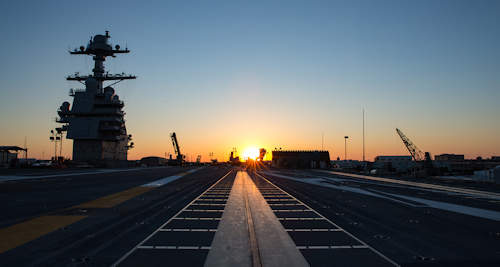After two years of delays and 13 billions of dollars, almost three times as much as one Nimitz, can't go into battle. This is the situation of the USS aircraft carrier Gerald R. Ford, the most expensive warship ever built.
The leader of the class Ford, according to a report signed by Michael Gilmore, director of operational tests and responsible for the evaluation of weapons systems for the Department of Defense, complains about "problems of poor or unknown reliability".
The report, delivered to the Pentagon, points the finger at the project of the leader of the class Ford. Gilmore writes: "Four of the main systems affect flight operations. Unless these problems are resolved by redesigning the aircraft launch systems, the CVN-78 carrier will have limited combat capabilities. "
For the first three carriers of the class Ford, the United States will spend 42 billion dollars. The Navy announced last week that the ship, which was due to enter service in September of the 2014, will not be delivered before next November this year due to "unspecified problems".
Gilmore continues: "Based on current estimates, it is unlikely that the CVN-78 could conduct high-intensity flight operations for more than 24 hours, compared to the four-day pre-requisite. My concerns about the reliability of these systems remain and the problems remain unresolved ".
According to the US Navy, ship construction is complete at 98 per cent while on-board tests have been completed for 89%. The first operational deployment of the Ford remains attached to the 2021, with sea trials for the 2018. There is therefore no time to correct deficiencies before potential combat operations.
And yet - adds Gilmore - the problems are fundamental to the ship's success.
 The central part of Gilmore's report is based on the system of launching and stopping the Ford, which reveals "insufficient reliability". "The arresting cable has the most serious limitations and is unlikely to withstand high-intensity flight operations. The reliability of 24 stops between critical launches, is well below expectations and to the minimum requirement to succeed in combat. The electromagnetic launching system is more reliable, but still raises concerns. Recent data indicates that the carrier can conduct 400 launches among critical failures. Unfortunately, well below the 4.166 requirement, you can take off ”.
The central part of Gilmore's report is based on the system of launching and stopping the Ford, which reveals "insufficient reliability". "The arresting cable has the most serious limitations and is unlikely to withstand high-intensity flight operations. The reliability of 24 stops between critical launches, is well below expectations and to the minimum requirement to succeed in combat. The electromagnetic launching system is more reliable, but still raises concerns. Recent data indicates that the carrier can conduct 400 launches among critical failures. Unfortunately, well below the 4.166 requirement, you can take off ”.
According to Gilmore, "to have 90's chance of completing 24 hours of extended operation, the system should ensure 1600 launches between critical failures."
To date, the USS Gerald R. Ford has a less than 7% chance of completing four days of combat.
"The reliability of the radar dual-band of the Raytheon Co. used for air traffic control and for self-defense against airplanes and missiles is unknown. The tests are still based on software under development and some hardware reliability problems have emerged. Despite failure rates, the radar will not be fully tested until the ship is at sea ".
La Ford is designed to have 11 elevators used to move weapons and equipment. "Their reliability is unknown and it is a risk."
The construction of the Ford began in November of the 2007: it will be the leader of the new class of carriers. Among the improvements introduced, a new nuclear power plant, a redesigned island, electromagnetic catapults, an optimized weapon system and a new flight deck. According to the specifications, the class Gerald R. Ford should be able to launch 220 planes a day, at the rate of one every six minutes.
In the 2013, the cost of the ship was estimated at 12,8 billion dollars, the 22 per cent more than expected in the 2008. 4.7 billions have also been spent on research and development. In the 2013, the Government Accountability Office complained of "unreliability in the ship's main systems that will be resolved only years after the first unit entered service. This will limit the effectiveness of the ship during initial distributions and will probably increase costs ".
The other two units of the class Ford, the USS John F. Kennedy and the new USS Enterprise (the USA will always have one at sea), should be commissioned respectively in the 2020 and in the 2025.
The total cost for the first three ships, out of the ten planned, is estimated at 43 billion dollars. The class Ford should be completed at a cost just under 120 billion.











